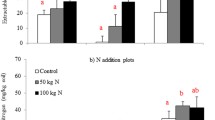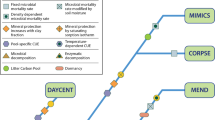Abstract
Due to global warming, interest in sequestering carbon by appropriately managing soils has contributed to studying the dynamic exchange of carbon and nitrogen in soils and atmospheric CO\(_2\). The priming effect, or the intensified CO\(_2\) emissions from soil organic matter (SOM) decomposition in short periods by using labile substrates, has been a topic of interest over the last decades. A combination of two experimentally supported mechanisms explains the priming effect phenomenon, and for the first time, we combine them in a novel stoichiometric model. The model considers the effects of labile substrate utilization in soils during the SOM decomposition and how CO\(_2\) emissions rates are affected. Laboratory data and a local sensitivity analysis validate the accuracy and robustness of the model. We find an optimized ratio of labile carbon and nitrogen that intensifies SOM decomposition for different soil features. The priming effect is weakened as C/N in SOM increases for nutrient-poor soils and is independent of C/N in SOM for nutrient-rich soils. The time required for microorganisms to decompose SOM at its maximum rate is delayed only for labile carbon treatments and poor-nutrient soils but remains constant otherwise. Finally, the SOM degradation efficiency determines the priming effect’s acceleration or reduction under different soil treatments.








Similar content being viewed by others
References
Alijani MK, Wang H, Elser JJ (2015) Modeling the bacterial contribution to planktonic community respiration in the regulation of solar energy and nutrient availability. Ecol Complex 23:25–33
Beeckman F, Motte H, Beeckman T (2018) Nitrification in agricultural soils: impact, actors and mitigation. Current Opin Biotechnol 50:166–173
Bhatti J, Tarnocai C (2009) Influence of climate and land use change on carbon in agriculture, forest, and peatland ecosystems across Canada. Soil Carbon Sequestration Greenh Effect 57:47–70
Blagodatskaya E, Kuzyakov Y (2008) Mechanisms of real and apparent priming effects and their dependence on soil microbial biomass and community structure: critical review. Biol Fertil Soils 45(2):115–131
Blagodatskaya E, Blagodatsky SA, Anderson TH et al (2007) Priming effects in chernozem induced by glucose and n in relation to microbial growth strategies. Appl Soil Ecol 37(1–2):95–105
Blagodatsky S, Blagodatskaya E, Yuyukina T et al (2010) Model of apparent and real priming effects: linking microbial activity with soil organic matter decomposition. Soil Biol Biochem 42(8):1275–1283
Chen R, Senbayram M, Blagodatsky S et al (2014) Soil C and N availability determine the priming effect: microbial N mining and stoichiometric decomposition theories. Global Change Biol 20(7):2356–2367
Craine JM, Morrow C, Fierer N (2007) Microbial nitrogen limitation increases decomposition. Ecology 88(8):2105–2113
Drake JE, Darby B, Giasson MA et al (2013) Stoichiometry constrains microbial response to root exudation-insights from a model and a field experiment in a temperate forest. Biogeosciences 10(2):821–838
Eppley RW, Rogers JN, McCarthy JJ (1969) Half-saturation constants for uptake of nitrate and ammonium by marine phytoplankton 1. Limnol Oceanogr 14(6):912–920
Falkowski P, Scholes R, Boyle E et al (2000) The global carbon cycle: a test of our knowledge of earth as a system. Science 290(5490):291–296
Fontaine S, Mariotti A, Abbadie L (2003) The priming effect of organic matter: a question of microbial competition? Soil Biol Biochem 35(6):837–843
Fontaine S, Hénault C, Aamor A et al (2011) Fungi mediate long term sequestration of carbon and nitrogen in soil through their priming effect. Soil Biol Biochem 43(1):86–96
Hessen DO, Ågren GI, Anderson TR et al (2004) Carbon sequestration in ecosystems: the role of stoichiometry. Ecology 85(5):1179–1192
Janssens I, Dieleman W, Luyssaert S et al (2010) Reduction of forest soil respiration in response to nitrogen deposition. Nature Geosci 3(5):315–322
Kong JD, Salceanu P, Wang H (2018) A stoichiometric organic matter decomposition model in a chemostat culture. J Math Biol 76(3):609–644
Kuzyakov Y (2010) Priming effects: interactions between living and dead organic matter. Soil Biol Biochem 42(9):1363–1371
Kuzyakov Y, Friedel J, Stahr K (2000) Review of mechanisms and quantification of priming effects. Soil Biol Biochem 32(11–12):1485–1498
Lal R, Follett RF (2009) Soil carbon sequestration and the greenhouse effect, vol 57. ASA-CSSA-SSSA
Lawrence CR, Neff JC, Schimel JP (2009) Does adding microbial mechanisms of decomposition improve soil organic matter models? A comparison of four models using data from a pulsed rewetting experiment. Soil Biol Biochem 41(9):1923–1934
Manlay RJ, Feller C, Swift M (2007) Historical evolution of soil organic matter concepts and their relationships with the fertility and sustainability of cropping systems. Agric Ecosyst Environ 119(3–4):217–233
Martin JP (1971) Decomposition and binding action of polysaccharides in soil. Soil Biol Biochem 3(1):33–41
Moorhead DL, Sinsabaugh RL (2006) A theoretical model of litter decay and microbial interaction. Ecol Monogr 76(2):151–174
Neill C, Gignoux J (2006) Soil organic matter decomposition driven by microbial growth: a simple model for a complex network of interactions. Soil Biol Biochem 38(4):803–811
Smith OL (1982) Soil microbiology: a model of decomposition and nutrient cycling. CRC Press, Inc., Boca Raton
Sterner RW, Elser JJ (2017) Ecological stoichiometry. Princeton University Press, Princeton
Stotzky G (2000) Soil Biochemistry. In: Books in soils, plants, and the environment. CRC Press, 200, https://books.google.ca/books?id=VI9N7b16CRoC
Sylvia DM, Fuhrmann JJ, Hartel PG, et al (2005) Principles and applications of soil microbiology. QR111 S674 2005, Pearson
Tate RL (1995) Soil microbiology. Wiley, New York
Wang H, Jiang L, Weitz JS (2009) Bacterivorous grazers facilitate organic matter decomposition: a stoichiometric modeling approach. FEMS Microbiol Ecol 69(2):170–179
Wang H, Sterner RW, Elser JJ (2012) On the strict homeostasis assumption in ecological stoichiometry. Ecol Modell 243:81–88
Wang H, Lu Z, Raghavan A (2018) Weak dynamical threshold for the strict homeostasis assumption in ecological stoichiometry. Ecol Modell 384:233–240
Acknowledgements
P Venegas Garcia was partially supported by El Consejo Nacional de Ciencia y Tecnologia (CONACYT #709985) and University of Alberta. H Wang was partially supported by Natural Sciences and Engineering Research Council of Canada (Collaborative Research and Development Grant, Individual Discovery Grant RGPIN-2020-03911, Discovery Accelerator Supplement Award RGPAS-2020-00090). This project was partially supported by Natural Sciences and Engineering Research Council of Canada (Collaborative Research and Development Grant).
Author information
Authors and Affiliations
Corresponding author
Ethics declarations
Conflict of interest
The authors declare that they have no conflict of interest.
Additional information
Publisher's Note
Springer Nature remains neutral with regard to jurisdictional claims in published maps and institutional affiliations.
Rights and permissions
Springer Nature or its licensor (e.g. a society or other partner) holds exclusive rights to this article under a publishing agreement with the author(s) or other rightsholder(s); author self-archiving of the accepted manuscript version of this article is solely governed by the terms of such publishing agreement and applicable law.
About this article
Cite this article
Venegas Garcia, P., Wang, H. A Data-Validated Stoichiometric Model for the Priming Effect. Bull Math Biol 85, 53 (2023). https://doi.org/10.1007/s11538-023-01160-5
Received:
Accepted:
Published:
DOI: https://doi.org/10.1007/s11538-023-01160-5




